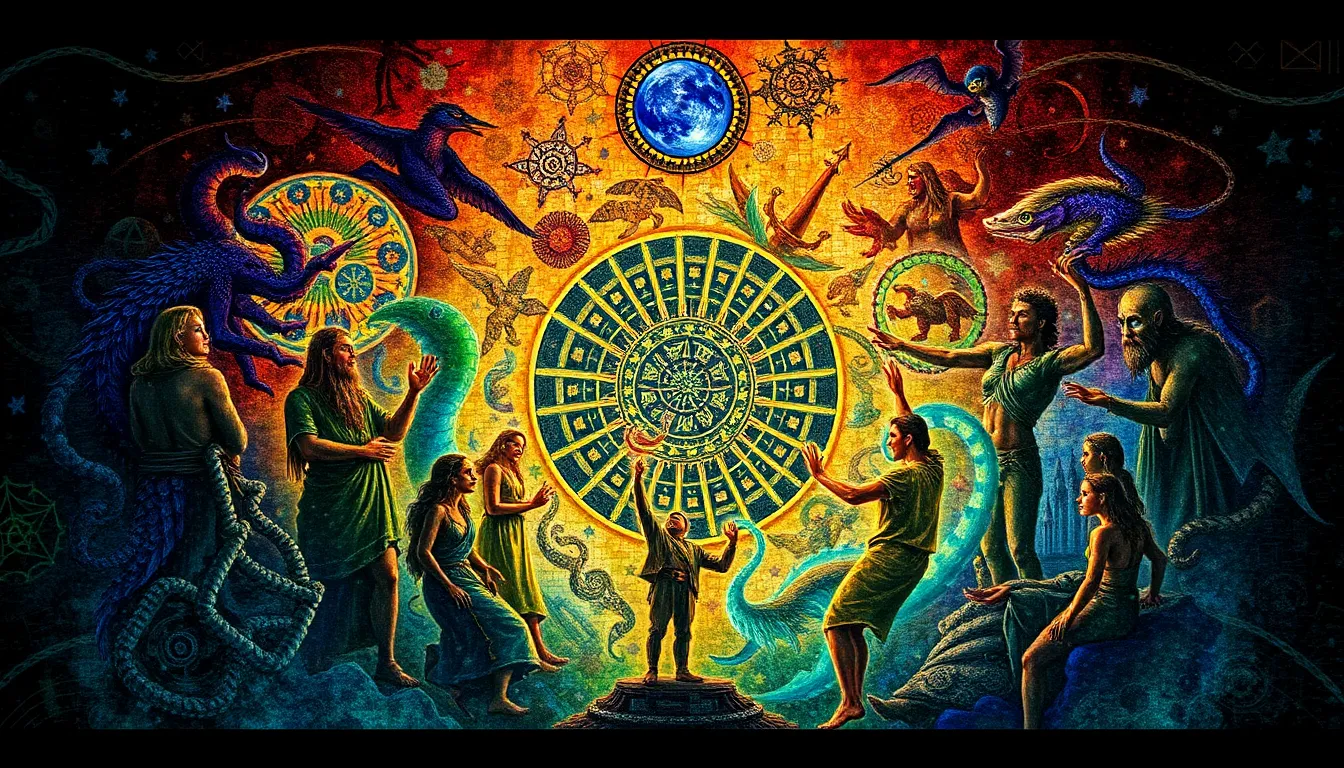The Sacred Mosaic: Diverse Myths in Sacred Places
I. Introduction to Sacred Places and Their Significance
Throughout history, sacred places have held profound significance for various cultures worldwide. These locations, often regarded as holy or spiritually potent, serve as touchstones for communal identity, worship, and cultural continuity. Sacred places can range from grand temples and ancient ruins to natural wonders such as mountains, rivers, and forests.
Mythology plays a crucial role in shaping our understanding of these sacred sites. Myths encapsulate the beliefs, values, and narratives of cultures, providing insights into how people relate to their environment and the divine. This article aims to explore the intricate relationship between diverse myths and sacred places, examining how they shape cultural identities, influence practices, and contribute to the sanctification of spaces.
II. The Role of Myths in Shaping Sacred Spaces
Myths are more than mere stories; they are foundational narratives that shape cultural identities and practices. They provide a framework for understanding the world and one’s place within it. Mythology influences cultural identity in several ways:
- Identity Formation: Myths contribute to a sense of belonging and shared history among community members.
- Explanation of Existence: They offer explanations for natural phenomena and life’s mysteries, often attributing them to divine forces.
- Guidance for Behavior: Myths often contain moral lessons and values that guide the actions of individuals and communities.
Furthermore, myths contribute to the sanctification of places by infusing them with spiritual meaning. For example, many natural landmarks are considered sacred due to the myths associated with them. These narratives often dictate rituals, practices, and the overall reverence shown to these spaces.
Case studies of notable myths that define sacred spaces include:
- The story of the creation of the world in various cultures, leading to the sanctification of certain locations.
- The myths surrounding Mount Olympus in Greece, which was viewed as the dwelling place of the gods.
- The legends of sacred rivers, such as the Ganges in India, where spiritual cleansing rituals take place.
III. Indigenous Myths and Their Sacred Landscapes
Indigenous cultures around the world have rich mythologies tied closely to their sacred landscapes. These beliefs often emphasize the interconnectedness of people, nature, and the spiritual realm. Indigenous practices are deeply rooted in the land, and sacred sites are often places of worship, gathering, and storytelling.
For example, in Native American cultures, sacred sites include:
- Mount Shasta: Considered a sacred mountain by various tribes, it is often associated with spiritual journeys and visions.
- The Black Hills: Revered by the Lakota Sioux, these hills are central to their creation stories and cultural identity.
Storytelling plays a vital role in passing down indigenous myths. These narratives are not just tales but are integral to the cultural fabric and identity of the community. They serve to educate younger generations about their heritage and the importance of their sacred landscapes.
IV. Ancient Civilizations: Myths and Their Temples
Ancient civilizations often constructed monumental architecture that was imbued with mythological significance. These structures were not only places of worship but also represented the civilization’s beliefs and values.
In Egyptian mythology, the pyramids served as monumental tombs for pharaohs, reflecting the belief in the afterlife and the divine nature of the rulers. The pyramids were aligned with celestial bodies, reinforcing the connection between the earth and the heavens.
Greek mythology gave rise to magnificent temples dedicated to a pantheon of gods. The Parthenon, for instance, was dedicated to Athena and symbolized the cultural achievements of Athens. These temples often housed statues and artifacts that told mythological stories.
Roman architecture also heavily incorporated mythology, as seen in structures like the Pantheon, which celebrated all gods. These architectural marvels were designed to evoke a sense of awe and connect the worshippers with the divine.
V. Eastern Spiritual Traditions and Sacred Geography
Eastern spiritual traditions have their own unique interpretations of sacred places, often intertwined with their mythologies. In Hinduism, the Ganges River is revered as the most sacred river, believed to cleanse sins and grant salvation. The river is personified as the goddess Ganga, and numerous myths surround its origins and spiritual significance.
Buddhism highlights Bodh Gaya as a significant site where Siddhartha Gautama attained enlightenment. This location is marked by the Mahabodhi Temple, and countless pilgrims visit to meditate and connect with the historical roots of their faith.
Taoism celebrates sacred mountains, such as Mount Tai, which are believed to be places of harmony between heaven and earth. These mountains are often depicted in myths as dwelling places for immortals and are integral to Taoist practices.
VI. The Intersection of Myth and Nature in Sacred Places
Nature serves as a canvas for mythological narratives, with various cultures attributing spiritual significance to natural features. Sacred forests, mountains, and rivers are often central to their respective mythologies. These locations are not only revered for their beauty but also for their spiritual essence.
For instance, in Japanese Shinto, natural elements like trees and rivers are considered kami (spirits). Sacred forests, such as the ancient cedar forests of Yakushima, are seen as manifestations of the divine. Environmental stewardship is often rooted in these mythological beliefs, encouraging communities to protect and honor their sacred landscapes.
VII. The Evolution of Sacred Myths in Modern Contexts
Globalization has influenced the evolution of sacred myths, often leading to the blending of traditional narratives with contemporary interpretations. As cultures interact, local myths can either be preserved or transformed.
Urbanization poses challenges to the preservation of sacred spaces. Many sacred sites face threats from development and commercialization. However, there are efforts to maintain the sanctity of these places through conservation and education.
Contemporary interpretations of ancient myths often emerge in literature, art, and media, reflecting the ongoing relevance of these narratives in modern society.
VIII. Pilgrimages: Journeys to Sacred Places
Pilgrimage is a significant aspect of many religions, representing a physical and spiritual journey to sacred sites. Historical significance is evident in various religions, where pilgrimage rituals are intertwined with mythological narratives.
Some major pilgrimage sites around the world include:
- Mecca: The Hajj pilgrimage is a key tenet of Islam, drawing millions of Muslims annually.
- Camino de Santiago: This Christian pilgrimage in Spain culminates at the shrine of St. James.
- Varanasi: A sacred city for Hindus, where pilgrims perform rituals along the Ganges.
The transformative power of pilgrimage experiences is profound, often leading individuals to spiritual awakening and deeper connections with their faith.
IX. The Role of Art and Literature in Conveying Sacred Myths
Art and literature play crucial roles in conveying and preserving sacred myths. Artistic representations of sacred places often capture the essence of the associated narratives, making them accessible to broader audiences.
Literature serves as a vessel for transmitting myths across generations. Epic tales, poetry, and modern storytelling adapt traditional myths, ensuring their survival in contemporary culture.
The modern adaptations of traditional myths can be seen in various media, from film and theater to digital storytelling, showcasing the enduring power of these narratives.
X. Conclusion: The Enduring Power of Myths in Sacred Places
The interconnectedness of myths and sacred places is a testament to the rich tapestry of human culture. Myths provide meaning and context to sacred spaces, shaping beliefs, practices, and identities across generations.
Preserving diverse mythologies is essential for maintaining cultural heritage and understanding the complexities of human experience. As we navigate the challenges of a globalized world, the future of sacred spaces and their associated myths will depend on our commitment to honoring and protecting these invaluable aspects of our shared humanity.



